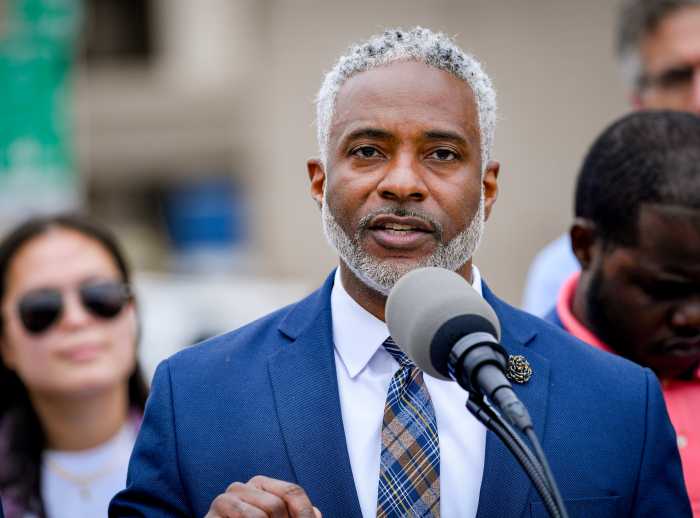BY COREY JOHNSON | On June 6, a 67-year-old woman was crossing West 38th Street when she was struck by a motorist making a turn onto Eighth Avenue. Tragically, she did not survive the crash. She is now one of 123 New Yorkers who have been killed in traffic fatalities in 2016 alone.
These terrible incidents are a jarring reminder of the need for Vision Zero, a city initiative that aims to achieve zero fatalities or serious injuries on our streets. Accidental traffic fatalities are, in many cases, avoidable, and our city can and must do more to protect lives and bring the number of those fatalities down to zero.
In Manhattan, pedestrians, trucks, cars, and bicycles share bustling streets, and this presents a great challenge. But it’s one we must overcome, and it’s going to take a range of approaches. I’d like to discuss some of them here.
Under the de Blasio administration, the Department of Transportation (DOT) has enacted many practical, effective, and lifesaving street improvements. Some of these initiatives are taking shape right at this very moment.
EXPRESS YOURSELVES
In Midtown, the DOT has been introducing split-phase signals at several problematic intersections. Split-phase signals give pedestrians a lead-time before cars can make a turn into the crosswalk. This is crucial, as two of the three pedestrian fatalities in Council District 3 this year were caused by the motorists’ failure to yield the right of way.
Split-phase turning is an improvement that should be expanded across the District, particularly at notoriously intersections like 41st Street and Dyer Avenue.
The DOT has also begun construction on a protected bike lane on Sixth Avenue from West Ninth Street to West 32nd Street. With shorter pedestrian crossings, traffic calming measures, traffic signals specifically designed for cyclists, and more, this project will bring greater safety to this busy corridor.
Street redesigns are necessary for a city that relies on a grid system built in 1811, and these targeted, effective solutions are going to make a big difference. I encourage the DOT to implement them wherever appropriate to ensure safety for pedestrian, cyclists, and motorists alike.
The increase in cycling has tremendous benefits, both for our environment and our overwhelmed transportation system. As the number of cyclists continues to grow, we need to create a culture of safety around biking that will benefit cyclists and pedestrians alike.
At the street design level, traffic signals that specifically target cyclists, like those we’ll see on Sixth Avenue, will certainly help and should be implemented more broadly. At the enforcement level, our public safety officials must ensure that cyclists are held accountable when they disobey existing traffic laws that protect both their safety and the safety of others.
And ultimately, as we discuss traffic and pedestrian safety, there is no way of getting around this startling fact: New York City receives 2.7 million cars from outside the city every single day.
Any serious effort to combat pedestrian injuries and fatalities must include a plan to reduce the number of cars on the road.
The Move NY Plan presents an appealing option. Under the plan, tolls would be enacted on East River crossings to Manhattan, while tolls would be reduced at bridges and tunnels in other boroughs. The idea is to limit the number of cars that pass through Manhattan and encourage the use of public transportation.
It’s a plan that has earned the respect of Ydanis Rodriguez, the City Council’s outstanding Transportation Committee chair, as well as an increasing number of elected officials at both the city and state level. I encourage the de Blasio administration and the DOT to look earnestly at this plan and consider adopting of some of its key components.
Of course, an intelligent tolling system won’t work all on its own — an “all of the above” approach is needed. New York State should revisit congestion pricing, which would limit the number of cars in Midtown during peak hours. We need to adequately invest in our public transportation system. We need to expand initiatives that are already proving successful, like split-phase timing and innovative street redesigns. And we need to invest in alternative forms of transportation for the West Side, like ferry service.
All across Council District 3, we are lucky to have outstanding transportation advocates. The transportation committees on our community boards are among the most active, and I’ve had the privilege of working closely with them. Organizations like Clinton Hell’s Kitchen Coalition for Pedestrian Safety (CHEKPEDS) and Transportation Alternatives are diligent and fierce advocates, and because of their work, we’ve already seen improvements on our streets that are saving lives.
I look forward to continuing my work with these leaders and organizations, and with you, members of the community, to implement bold solutions for the safety of all New Yorkers.
Together, I know we can achieve Vision Zero. Lives are depending on it.
City Councilmember Corey Johnson, a Democrat, represents District 3 on Manhattan West Side. For more information on the city’s Vision Zero initiative, visit nyc.gov/html/visionzero/pages/home/home.shtml.




























